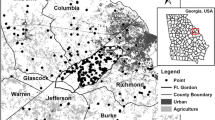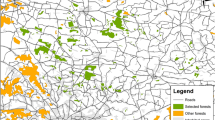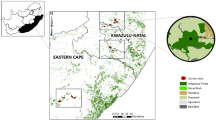Abstract
Increasing land conversion of agriculture and forest by urban growth in the southern United States has altered the landscape matrix surrounding pine forests, creating varying mixtures of urban and agricultural cover types. I investigated the avian diversity-environment relationship in the southern pine forests along an urban-agriculture-wildland gradient by quantifying multiple dimensions of biodiversity: taxonomic (Shannon-Wiener index), functional (RaoQ and its standardized effect size), and phylogenetic (mean pairwise distance, mean nearest taxon distance, and their standardized effect size) diversity. I also considered habitat guilds and single traits correlated with RaoQ. I used breeding bird data collected at 162 pine stands in Georgia. Taxonomic and functional diversity increased with agricultural cover within the landscape (1 km-radius area). In particular, shrub habitat guild and shrub nesters showed a strong positive response to the variable. Insectivores and tree nesters (two predominant traits in pine forests) responded negatively to urban and agricultural covers. Both taxonomic and functional diversity decreased and increased with increasing hardwood vegetation cover and herbaceous vegetation cover within a stand, respectively. Pine-grassland and shrub habitat guilds, omnivores, and shrub nesters also showed the similar responses to these variables. Phylogenetic diversity metrics were not associated with environmental variables. The findings of this study suggest that open habitat features within a stand are important to promote functional diversity as well as taxonomic diversity in pine forests. They also indicate that agricultural matrix does not act as an environmental filter and low to moderate levels of less intensive agricultural (hay/pasture) matrix may improve avian diversity.




Similar content being viewed by others
References
Allen AW, Bernal YK, Moulton RJ (1996) Pine plantations and wildlife in the southeastern United States: an assessment of impacts and opportunities. US Department of the Interior National Biological Service Information and Technology. Report 3
Aronson MFJ, La Sorte FA, Nilon CH et al (2014) A global analysis of the impacts of urbanization on bird and plant diversity reveals key anthropogenic drivers. Proc R Soc B 281:20133330
Beninde J, Veith M, Hochkirch A (2015) Biodiversity in cities needs space: a metaanalysis of factors determining intra-urban biodiversity variation. Ecol Lett 18:581–592
Bivand RS, Pebesma E, Gomez-Rubio V (2013) Applied spatial data analysis with R, 2nd edn. Springer, New York
Bregman TP, Lees AC, MacGregor HEA, Daski B, de Moura NG, Aleixo A, Barlow J, Tobias JA (2016) Using avian functional traits to assess the impact of land-cover change on ecosystem processes linked to resilience in tropical forests. Proc R Soc B 283:20161289
Brockway DG, Outcalt KW, Tomczak DJ, Johnson EE (2005) Restoration of Longleaf Pine Ecosystems. Gen Tech Rep GTR-SRS-83 USDA For. Serv Southern Res Sta Asheville, NC
Cadotte MW, Cascadden K, Mirotchnick N (2011) Beyond species: functional diversity and the maintenance of ecological processes and services. J Appl Ecol 48:1079–1087
Cadotte MW, Dinnage R, Tilman D (2012) Phylogenetic diversity promotes ecosystem stability. Ecology 93:S223–S233
Canterbury GE, Martin TE, Petit DR, Petit LJ, Bradford DF (2000) Bird communities and habitat as ecological indicators of forest conditions in regional monitoring. Conserv Biol 14:544–558
Chace JF, Walsh JJ (2006) Urban effects on native avifauna: a review. Landscape Urban Plan 74:46–69
Cumming GS, Child MF (2009) Contrasting spatial patterns of taxonomic and functional richness offer insights into potential loss of ecosystem services. Philos Trans R Soc B 364:1683–1692
Díaz S, Cabido M (2001) Vive la difference: plant functional diversity matters to ecosystem processes. Trends Ecol Evol 16:646–655
Dickson JG, Thompson FR III, Conner RN, Franzreb KE (1993) Effects of silviculture on neotropical migratory birds in central and southeastern oak pine forests. In: Finch DM, Stangel PM (eds) Status and management of neotropical migratory birds, Gen Tech Rep RM-229 USDA For Serv Colorado, pp 374–385
Drummond AJ, Rambaut A (2007) BEAST: Bayesian evolutionary analysis by sampling trees. BMC Evol Biol 7:214
Dunning JB Jr (2008) CRC handbook of avian body masses, 2nd edn. CRC Press, Boca Raton, Florida
Dunning JB Jr, Watts BD (1990) Regional differences in habitat occupancy by Bachman’s sparrow. Auk 107:463–472
Endenburg S, Mitchell GW, Kirby P, Fahrig L (2019) The homogenizing influence of agriculture on forest bird communities at landscape scales. Landscape Ecol 34:2385–2399
Fahrig L (2001) How much habitat is enough? Biol Conserv 100:65–74
Fahrig L, Baudry J, Brotons L, Burel FG, Crist TO, Fuller RJ, Sirami C, Siriwardena GM, Martin J-L (2011) Functional landscape heterogeneity and animal biodiversity in agricultural landscapes. Ecol Lett 14:101–112
Filippi-Codaccionia O, Clobert J, Julliard R (2009) Urbanisation effects on the functional diversity of avian agricultural communities. Acta Oecol 35:705–710
Flynn DFB, Gogol-Prokurat M, Nogeire T, Molinari N, Richers BT, Lin BB, Simpson N, Mayfield MM, DeClerck F (2009) Loss of functional diversity under land use intensification across multiple taxa. Ecol Lett 12:22–33
Flynn DFB, Mirotchnick N, Jain MI, Palmer S, Naeem (2011) Functional and phylogenetic diversity as predictors of biodiversity–ecosystem-function relationships. Ecology 92:1573–1158
Flohre A, Fischer C, Aavik T et al (2011) Agricultural intensification and biodiversity partitioning in European landscapes comparing plants carabids and birds. Ecol Appl 21:1772–1781
Frishkoff LO, Karp DS, M’Gonigle LK, M’Gonigle LK, Mendenhall CD, Zook J, Kremen C, Hardly EA, Daily GC (2014) Loss of avian phylogenetic diversity in neotropical agricultural systems. Science 345:1343–1346
Garnier E, Cortez J, Billes G, Navas ML, Roumet C, Debussche M, Laurent G, Blanchard A, Aubry D, Bellmann A, Neill C, Toussaint JP (2004) Plant functional markers capture ecosystem properties during secondary succession. Ecology 85:2630–2637
Gossner MM, Lewinsohn TM, Kahl T et al (2016) Land-use intensification causes multitrophic homogenization of grassland communities. Nature 540:266–269
Gotelli NJ, Rohde K (2002) Co-occurrence of ectoparasites of marine fishes: A null model analysis. Ecol Lett 5:86–94
Grab H, Branstetter MG, Amon N, Urban-Mead KR, Park MG, Gibbs J, Blitzer EJ, Poveda K, Loeb G, Danforth BN (2019) Agriculturally dominated landscapes reduce bee phylogenetic diversity and pollination services. Science 363:282–284
Greene RE, Iglay RB, Evans KO (2019) Providing open forest structural characteristics for high conservation priority wildlife species in southeastern US pine plantations. Forest Ecol Manag 453:117594
Hooper DU, Chapin FS, Ewel JJ, Hector A, Inchausti P, Lavorel S, Lawton JH, Lodge DM, Loreau M, Naeem S, Schmid B, Setala H, Symstad AJ, Vandermeer J, Wardle DA (2005) Effects of biodiversity on ecosystem functioning: a consensus of current knowledge. Ecol Monogr 75:3–35
Huggett R, Wear DN, Li R, Coulston J, Liu S (2013) Forecasts of forest conditions. In: Wear DN, Greis JG (eds) The southern forest futures project. Gen Tech Rep SRS-178 USDA For Serv Southern Res Sta, pp 73–101
Ibáñez-Álamo JD, Rubio E, Benedetti Y, Morelli F (2017) Global loss of avian evolutionary uniqueness in urban areas. Global Change Biol 23:2990–2998
Jetz W, Thomas GH, Joy JB, Hartmann K, Mooers AO (2012) The global diversity of birds in space and time. Nature 491:444–448
Jose S, Jokela EJ, Miller DL (2006) The longleaf pine ecosystem: an overview. In: In: Jose S, Jokela EJ, Miller DL (eds) The longleaf pine ecosystem: ecology silviculture and restoration. Springer, New York, pp 3–8
Kark S, Iwaniuk A, Schalimtzek A, Banker E (2007) Living in the city: can anyone become an ‘urban exploiter’? J Biogeor 34:638–651
Kembel SW, Cowan PD, Helmus MR, Cornwell WK, Morlon H, Ackerly DD, Blomberg SP, Webb CO (2010) Picante: R tools for integrating phylogenies and ecology. Bioinformatics 26:1463–1464
Kissling WD, Carl G (2008) Spatial autocorrelation and the selection of simultaneous autoregressive models. Glob Ecol Biogeogr 17:59–71
Laliberté E, Legendre P, Shipley B (2014) FD: measuring functional diversity from multiple traits, and other tools for functional ecology. R package version 1.0-12
Lane VR, Miller KV, Castleberry SB, Cooper RJ, Miller DA, Wigley TB, Marsh GM, Mihalco RL (2011) Bird community responses to a gradient of site preparation intensities in pine plantations in the Coastal Plain of North Carolina. For Ecol Manage 262:1668–1678
Lee M-B (2013) Avian biodiversity along an urban–rural/agriculture–wildlife gradient. Dissertation, University of Georgia
Lee M-B, Carroll JP (2014) Relative importance of local and landscape variables on site occupancy by avian species in a pine forest urban and agriculture matrix. Forest Ecol Manag 320:161–170
Lee M-B, Carroll JP (2015) Avian diversity in pine forests along an urban-rural/agriculture—wildland gradient. Urban Ecosyst 18:685–700
Lee M-B, Carroll JP (2018) Effects of patch size and basal area on avian taxonomic and functional diversity in pine forests: implication for the influence of habitat quality on the species-area relationship. Ecol Evol 8:6909–6920
Loehle C, Wigley TB, Rutzmoser S et al (2005) Managed forest landscape structure and avian species richness in the southeastern US. Forest Ecol Manag 214:279–293
Loehle C, Wigley TB, Schilling E, Tatum V, Beebe J, Vance E, Van Deusen P, Weatherford P (2009) Achieving conservation goals in managed forests of the Southeastern Coastal Plain. Environ Manage 44:1136–1148
Luck GW, Lavorel S, McIntyre S, Lumb K (2012) Improving the application of vertebrate trait-based frameworks to the study of ecosystem services. J Anim Ecol 81:1065–1076
Marzluff JM (2001) Worldwide urbanization and its effects on birds. In: Marzluff JM, Bowman R, Donnelly RE (eds) Avian conservation and ecology in an urbanizing world. Norwell Kluwer, pp 19–47
Mason NWH, de Bello F, Mouillot D, Pavoine S, Dray S (2013) A guide for using functional diversity indices to reveal changes in assembly processes along ecological gradients. J Veg Sci 24:794–806
Matuoka MA, Benchimol M, de Almeida-Rocha JM, Morante-Filho JC (2020) Effects of anthropogenic disturbances on bird functional diversity: a global meta-analysis. Ecol Indic 116:106471
Mayfield MM, Levine JM (2010) Opposing effects of competitive exclusion on the phylogenetic structure of communities. Ecol Lett 13:1085–1093
Mazel F, Pennell M, Cadotte M, Diaz S, Riva GD, Grenyer R, Leprieur F, Mooers A, Mouillot D, Tucker C, Pearse W (2018) Prioritizing phylogenetic diversity captures functional diversity unreliably. Nat Commun 9:288
McGarigal K, Marks BJ (1995) FRAGSTATS: spatial pattern analysis program for quantifying landscape structure. Gen Tech Rep PNW-GTR-351 USDA For. Serv Pacific Northwest Res Sta Portland
McGarigal K, Cushman SA, Ene E (2012) FRAGSTATS v4: Spatial pattern analysis program for categorical and continuous maps. Available at http://www.umassedu/landeco/research/fragstats/fragstats.html
McIntyre RK, Conner LM, Jack SB, Schlimm EM, Smith LL (2019) Wildlife habitat condition in open pine woodlands: field data to refine management targets. Forest Ecol Manag 437:282–294
McPhearson T, Auch R, Alberti M (2013) Regional Assessment of North America: urbanization trends biodiversity patterns and ecosystem services. In: In: Elmqvist T, Fragkias M, Goodness J et al (eds) Urbanization biodiversity and ecosystem services: challenges and opportunities. Springer, New York, pp 279–286
Melchiors MA (1991) Wildlife management in southern pine regeneration systems. In: In: Duryea ML, Dougherty PM (eds) Forest Regeneration Manual. Kulwer Academic Publishers, The Netherlands, pp 391–420
Meynard CN, Devictor V, Mouillot D, Thuiller W, Jiguet F, Mouquet N (2011) Beyond taxonomic diversity patterns How do a b and g components of bird functional and phylogenetic diversity respond to environmental gradients across France? Global Ecol Biogeogr 20:893–903
Miller DA, Wigley TB, Miller KV (2009) Managed forests and conservation of terrestrial biodiversity in the southern United States. J Forest 107:197–203
Miles AC, Castleberry ST, Miller DA, Conner LM (2010) Multi-scale roost‐site selection by Evening bats on pine‐dominated landscapes in Southwest Georgia. J Wild Manag 70:1191–1199
Mitchell MS, Rutzmser SH, Wigley TB, Loehle C, Gerwin JA, Keyser PD, Lancia RA, Perry RW, Reynolds CJ, Thill RE, Weih R, White D, Wood PB (2006) Relationship between avian richness and landscape structure at multiple scales using multiple landscapes. Forest Ecol Manag 221:155–169
Monnet AC, Jiguet F, Meynard CN, Mouillot D, Mouquet N, Thuiller W, Devictor V (2014) Asynchrony of taxonomic functional and phylogenetic diversity in birds. Global Ecol Biogeogr 23:780–788
Morelli F, Benedetti Y, Ibáñez-Álamo JD, Jokimäki J, Mäand R, Tryjanowski P, Møller AP (2016) Evidence of evolutionary homogenization of bird communities in urban environments across Europe. Global Ecol Biogeogr 25:1284–1293
Mouchet MA, Villeger S, Mason NWH, Mouillot D (2010) Functional diversity measures: an overview of their redundancy and their ability to discriminate community assembly rules. Funct Ecol 24:867–876
Pakeman RJ (2011) Functional diversity indices reveal the impacts of land use intensification on plant community assembly. J Ecol 99:1143–1151
Provencher L, Gobris NM, Brennan LA, Gordon DR, Hardesty JL (2000) Breeding bird response to midstory hardwood reduction in Florida Sandhill longleaf pine forests. J Wild Manag 66:641–661
Ralph CJ, Geupel GR, Pyle P, Martin TE, DeSante DF (1993) Handbook of field methods for monitoring landbirds. Gen Tech Rep PSW-GRT-144 USDA For Serv Pacific Southwest Res Sta
Ricotta C, Moretti (2011) CWM and Rao’s quadratic diversity: a unified framework for functional ecology. Oecologia 167:181–188
Robbings P, Birkenholtz T (2003) Turfgrass revolution measuring the expansion of the American lawn. Land Use Policy 20:181–194
Sax DF, Gaines SD, Brown JH (2002) Species invasions exceed extinctions on islands worldwide: a comparative study of plants and birds. Am Nat 160:766–783
Smith WB, Miles PD, Perry CH, Pugh SA (2009) Forest Resources of the United States 2007. Gen Tech Rep WO-78 USDA For Serv Washington DC
Sol D, Bartomeus I, Gonzalez-Lagos C, Pavoine S (2017) Urbanisation and the loss of phylogenetic diversity in birds. Ecol Lett 20:721–729
Sol D, Trisos C, Múrria C, Jeliazkov A, González-Lagos C, Pigot AL, Ricotta C, Swan CM, Tobias JA, Pavoine S (2020) The worldwide impact of urbanisation on avian functional diversity. Ecol Lett 23:962–972
Swenson NG (2014) Functional and phylogenetic ecology in R. Springer, New York
Tews J, Brose U, Grimm V, Tielbörger K, Wichmann MC, Schwager M, Jeltsch F (2004) Animal species diversity driven by habitat heterogeneity/diversity: the importance of key structures. J Biogeogr 31:79–92
Tilman D (2001) Functional diversity. In: Levin SA (ed) Encyclopedia of biodiversity. Academic Press, pp 109–120
Tucker CM, Cadotte MW (2013) Unifying measures of biodiversity: understanding when richness and phylogenetic diversity should be congruent. Divers Distrib 19:845–854
Tucker CM, Cadotte MW, Carvalho SB et al (2016) A guide to phylogenetic metrics for conservation community ecology and macroecology. Biol Rev 92:698–715
Van Lear DH, Carroll WD, Kapeluck PR, Johnson R (2005) History and restoration of the longleaf pine-grassland ecosystem: implications for species at risk. Forest Ecol Manag 211:150–165
Veldman JW, Brudvig LA, Damschen EI, Orrock JL, Mattingly WB, Walker JL (2014) Fire frequency agricultural history and the multivariate control of pine savanna understorey plant diversity. J Veg Sci 25:1438–1449
Waldron JL, Welch SM, Bennett SH (2008) Vegetation structure and the habitat specificity of a declining North American reptile: a remnant of former landscapes. Biol Conserv 141:2477–2482
Weideman EA, Slingsby JA, Thomson RL, Coetzee BTW (2020) Land cover change homogenizes functional and phylogenetic diversity within and among African savanna bird assemblages. Landscape Ecol 35:145–157
Webb CO, Ackerly DD, McPeek MA, Donoghue MJ (2002) Phylogenies and community ecology. Annu Rev Ecol Syst 33:475–505
Wilson CW, Masters RE, Bukenhofer GA (1995) Breeding bird response to pine grassland community restoration for red-cockaded woodpeckers. J Wildlife Manage 59:56–67
Acknowledgements
This work was supported by McIntire-Stennis Project GEOZ 136 and GDAS Special Project of Science and Technology Development 2020GDASYL-20200103089. I would like to thank Georgia Ornithological Society for additional research grant. I also thank all staff at the Fort Gordon Natural Resources Branch for their help, field technicians for their hard work, Dr. J. Carroll for advice on this project, and Dr. J. Rotenberry for comments and edits on the draft of this manuscript.
Author information
Authors and Affiliations
Corresponding author
Ethics declarations
Not applicable: Research grant is indicated above (Acknowledgements).
Conflicts of interest
There are no conflicts of interest.
Additional information
Communicated by Grzegorz Mikusinski.
Publisher’s Note
Springer Nature remains neutral with regard to jurisdictional claims in published maps and institutional affiliations.
This article belongs to the Topical Collection: Forest and plantation biodiversity.
Electronic Supplementary Material
Below is the link to the electronic supplementary material.
Rights and permissions
About this article
Cite this article
Lee, MB. Multiple facets of avian diversity in pine forests along an urban-agricultural gradient. Biodivers Conserv 31, 497–516 (2022). https://doi.org/10.1007/s10531-021-02345-x
Received:
Revised:
Accepted:
Published:
Issue Date:
DOI: https://doi.org/10.1007/s10531-021-02345-x




